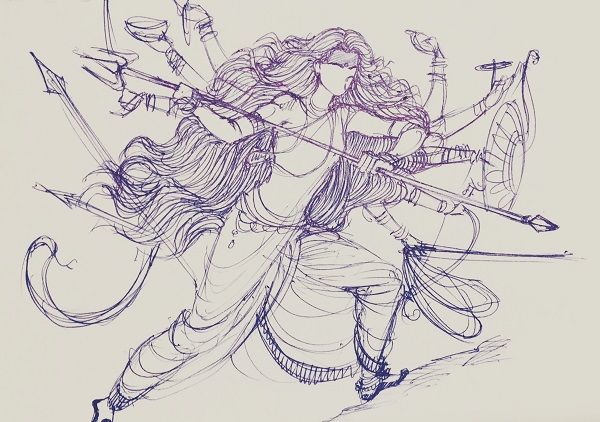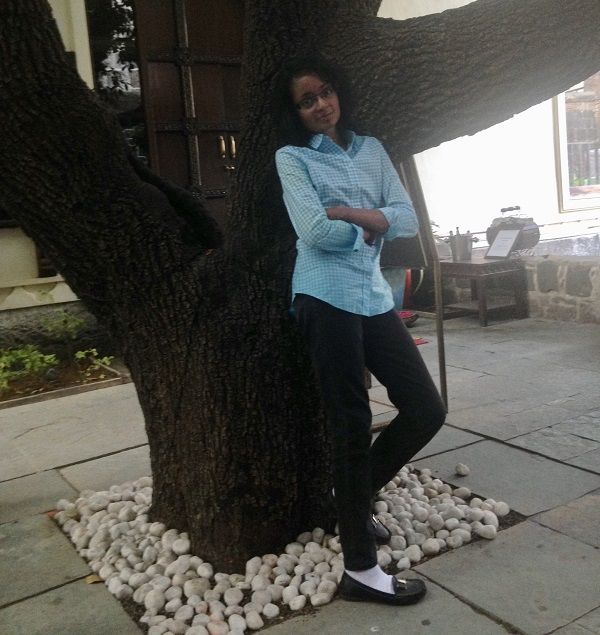
Srishti Rai, 24, was born with Epidermolysis Bullosa, a rare genetic skin disease. Here, she talks about how she fights for her health every day and her passion for animation. And why she thinks jeans are over-rated.
I was born seeming like a “normal” child late one February night, except for a couple of small red bruises on my chin and my ankle from the delivery. This was a little unusual, so I was taken to have the bruises treated. That’s when it was discovered that things were not as simple as they looked. When the nurse held me by my feet to treat the bruises, I pulled my feet out of her grip—and a layer of my skin came off in her hands like a sock. It was unlike anything anyone there had seen or known before. My skin was severely injured with even the smallest impact or contact.
After a dermatologist was rushed in to try and figure out what we were dealing with, I was diagnosed with one form of a very rare genetic condition called Epidermolysis bullosa (EB for short). Healthy skin has several layers that are bound together and held in place by a protein called collagen type 7, and I happened to lack this protein in sufficient quantities, resulting in my skin being very easily damageable. This condition occurs in about 1 in 50,000 children.
Sufferers of this condition are often called “butterfly children” because of the extent of delicateness our skin is in the more severe cases.
“Was she burned?”
Once I was diagnosed and brought home, my family realised they could not even cuddle or hold me against them without heavy protection around me, as my skin would badly bruise or peel off. In fact, for the first several months I had to be swathed in soft blankets or carried on a pillow around the house. It was a challenge for my mother to help me with tasks that don’t take a passing thought for most other people. Bath time continues to be a severely painful ordeal even now, but back then it was much worse—the edge of a towel could give me large and painful injuries and my own dress could cut my hands and legs. Crawling was never an option for me since my knees would immediately injure and bleed and the stress and exertion would not allow the wounds to heal normally at all. I have been luckier than a lot of people that suffer EB in this regard—I never crawled. I directly started walking.
My mother tirelessly bandaged all my wounds when I was young, and together we discovered how to give these injuries the best chance to heal. She found that although normal bandages would do more damage to the wound than good and prolong the healing process because they stuck to the wounds and then had to be ripped off, a medicated non-sticky gauze applied over the wound helped the skin heal faster due to less damage. This didn’t decrease the severe pain, but it made things a lot easier to deal with.
Who needs jeans when you have comfortable Indian wear?
Everything my mother did was to make sure I hurt as less as possible, and this was the case with clothes-shopping too. Everything I wore had to be loose with no rough folds or stitching lines, nothing that would rub against the skin. But one of the most beautiful things about life in India is that we have traditional clothes that happen to fit the description of everything I needed to allow my skin to breathe. I was usually either in soft little frocks and paawdas (little roomy kurta-salwars) that my Nani (my maternal grandmother) had lovingly made for me with her own hands. I also loved snuggling into her soft saris and draping my mother’s dupatta around myself like a sari because I wanted to be just like my Nanimaa, and later on I absolutely loved walking around in a nauvari—a traditional Maharashtrian sari, nine yards long, that looked so beautiful and didn’t restrict movement the way trousers sometimes can. I always say western wear is overrated.
Going to school
My mother and my Nanimaa took care of my education until I was eight years old. They were the most beautiful teachers anyone could hope to learn from. Once it was felt that I was ready to face a bigger world than my own family, I was admitted to a regular school—Delhi Public School (DPS) Patna. Before I joined, my mother wrote a letter to the principal detailing the condition I was dealing with, and the school made sure that all the students, including and especially my future classmates, had been sensitised about it. My mother joined school with me as a teacher just to be able to be there for any emergencies I had. I was treated as a special child—all the children had been alerted not to run at me or bump into me. I was excused from physical education classes, but I took delight in sitting near my classmates and watching them play.
Halfway into grade 6, something magical happened—my father was transferred to Pune, the city my mother had grown up in and whose image I already had in my mind as one of the most beautiful places that existed on earth. I moved to the Pune branch of DPS, which was possible since the person I owe my education to and the person that went out of his way to make me feel welcome in a new environment, Sanjiv Kumar, secretary of Takshila Educational Society, ran both the Pune and Patna branches of DPS. I expected the same special treatment I had become used to in Patna, but this was Pune and it was full of pleasant surprises, like it always has been and will be. My mother left school when I was in grade 7 to give me a chance to develop my confidence, but was always available since we lived very close to school.
While my classmates were very careful about me, they never let me feel like I was any different. They always ran around near me and fought each other and knocked over all the furniture the class had, but they never let any harm come to me. In the rare event that I slipped and fell down and badly hurt myself, when I was bleeding through my uniform and crying out of fear of both wounds that would take painful weeks to heal and of what everyone might think of me now, they were always quick to call my mother into school for help and never made a big deal out of something that can be extremely alienating and embarrassing in front of what I call a “normal” crowd.
Pune was the city that gave me the chance to come out of my shell. It was where I learned to socialise, to navigate my way through a heavy crowd by myself without falling or being afraid, to expand my horizon about what was out there for me—not as a person with a special condition, but as a person with unique interests. It was where I drowned out the pain by reading books about Shivaji Maharaj, discovering music and a culture so different from my own but one I instantly connected deeply with, and learning to discover my own self, my mind, and my likes and dislikes, when for so many years I had been in a dark cloud of discomfort and was in too much pain to bother how to stop it.
Art gave me strength
I had been drawing since I was able to hold a pen, and I would scribble what my tiny self thought was fine art on any blank white surface I could find, including the walls of our Patna house. I had somehow always found a deep connection with a certain ten-armed woman with long, black tresses, deftly wielding dozens of weapons to fight off evil—known to India as the mother goddess Durga—and when I was in severe pain from my injuries or just the endless pain I felt in my skin, I drew images of her on the battlefield, fighting demons and protecting everyone the way I knew she was protecting me from pain that could’ve been so much worse.

Art has always been a brilliant escape from the pain, and I kept practising over the years. Then I discovered magic—I found that there were people that did drawings that moved over time to tell a story for a living, and these amazing creatures that breathed life into blank space and deadlines were called animators! I knew right there, when I was eight years old, that I wanted to be one of them, and I quickly set my sights on Pixar Animation Studios, one of the greatest pioneers of the field and one of the greatest functioning studios today. I went on practising, joined a five year animation course in Pune after school with no Plan B, skipped a year on merit, and now I work at Technicolor in Bangalore, the best studio in the country.
Never lose hope
Though EB doesn’t have a known cure, and it is a daunting challenge with a steep learning curve if you don’t know what you’re dealing with, it can be managed well enough for a patient to have a semblance of what life is like without it. I can’t do a lot of things the way others can, but I can figure out my own way of doing things. EB causes pain, pain causes depression which is also something I deal with, and depression leaves one with little energy to care for your physical or mental health, but everything is always easier when one is not alone.

I am registered with DEBRA International, the umbrella organisation for Epidermolysis Bullosa. It is a good place for others with EB to connect and share experiences so no one has to go through this all alone.
My parents and my Nanimaa and Nanaji have been my biggest support. I would not have made it this far without their undying love and their tireless support. I can only hope I can pay them all back one day.
Till then, watch out for my name in the end credits!






